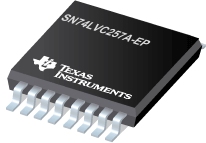

SN74LVC257A-EP是TI公司的一款解码器/编码器/多路复用器产品,SN74LVC257A-EP是具有三态输出的增强型产品四路 2 线路到 1 线路数据选择器/多路复用器,本页介绍了SN74LVC257A-EP的产品说明、应用、特性等,并给出了与SN74LVC257A-EP相关的TI元器件型号供参考。
SN74LVC257A-EP - 具有三态输出的增强型产品四路 2 线路到 1 线路数据选择器/多路复用器 - 解码器/编码器/多路复用器 - 特殊逻辑 - TI公司(Texas Instruments,德州仪器)
- Controlled Baseline
- One Assembly/Test Site, One Fabrication Site
- Extended Temperature Performance of -55°C to 125°C
- Enhanced Diminishing Manufacturing Sources (DMS) Support
- Enhanced Product-Change Notification
- Qualification Pedigree(1)
- ESD Protection Exceeds 2000 V Per MIL-STD-883, Method 3015; Exceeds 200 V Using Machine Model (C = 200 pF, R = 0)
- Operates From 2 V to 3.6 V
- Inputs Accept Voltages to 5.5 V
- Max tpd of 4.6 ns at 3.3 V
- Typical VOLP (Output Ground Bounce) <0.8 V at VCC = 3.3 V, TA = 25°C
- Typical VOHV (Output VOH Undershoot) >2 V at VCC = 3.3 V, TA = 25°C
(1) Component qualification in accordance with JEDEC and industry standards to ensure reliable operation over an extended temperature range. This includes, but is not limited to, Highly Accelerated Stress Test (HAST) or biased 85/85, temperature cycle, autoclave or unbiased HAST, electromigration, bond intermetallic life, and mold compound life. Such qualification testing should not be viewed as justifying use of this component beyond specified performance and environmental limits.
DESCRIPTION/ORDERING INFORMATION
The SN74LVC257A-EP quadruple 2-line to 1-line data selector/multiplexer is designed for 2.7-V to 3.6-V VCC operation.
The device is designed to multiplex signals from 4-bit data sources to 4-output data lines in bus-organized systems. The 3-state outputs do not load the data lines when the output-enable (OE) input is at a high logic level.
Inputs can be driven from either 3.3-V or 5-V devices. This feature allows the use of this device as a translator in a mixed 3.3-V/5-V system environment.
To ensure the high-impedance state during power up or power down, OE should be tied to VCC through a pullup resistor; the minimum value of the resistor is determined by the current-sinking capability of the driver.







